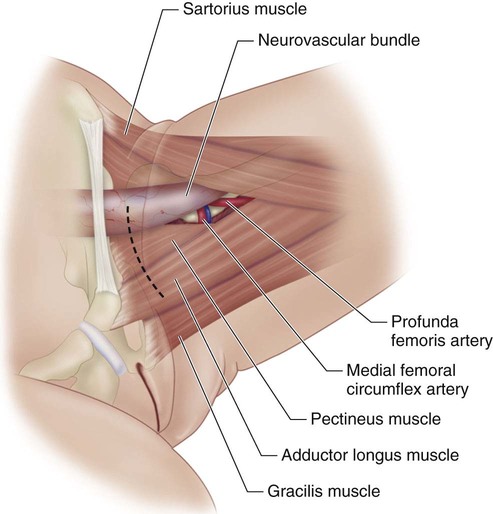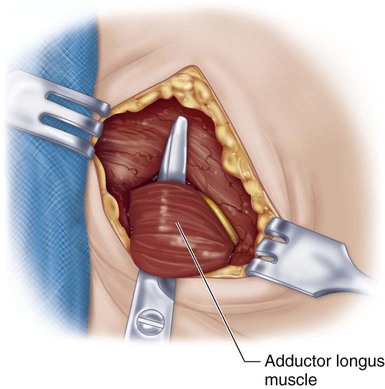Anteromedial Approach to a Developmentally Dislocated Hip
Indications
 The indication for the anteromedial approach in a developmentally dislocated hip is when concentric reduction cannot be obtained or maintained by closed methods.
The indication for the anteromedial approach in a developmentally dislocated hip is when concentric reduction cannot be obtained or maintained by closed methods.
 It is ideal for children under 18–24 month of age, although the author has used it in older patients when open reduction is the only procedure planned.
It is ideal for children under 18–24 month of age, although the author has used it in older patients when open reduction is the only procedure planned.
 The advantages of this particular approach are avoidance of injury to the hip abductor muscles and to the growth plate of the iliac crest, and a scar that is well hidden.
The advantages of this particular approach are avoidance of injury to the hip abductor muscles and to the growth plate of the iliac crest, and a scar that is well hidden.
 Blood loss is minimal, usually less than 20 ml per hip, and both hips can be operated on safely in the same operative session.
Blood loss is minimal, usually less than 20 ml per hip, and both hips can be operated on safely in the same operative session.
Surgical Anatomy
 The key anatomic relationships to understand in the anteromedial approach are the relationship of the neurovascular bundle to the pectineus; the location of the medial femoral circumflex vessels; the relationship of the anterior branch of the obturator nerve to the adductor longus and brevis; the relationship of the lesser trochanter and the iliopsoas tendon to the neurovascular bundle and the pectineus; and finally the relationship of the anteromedial hip joint capsule to the overlying structures.
The key anatomic relationships to understand in the anteromedial approach are the relationship of the neurovascular bundle to the pectineus; the location of the medial femoral circumflex vessels; the relationship of the anterior branch of the obturator nerve to the adductor longus and brevis; the relationship of the lesser trochanter and the iliopsoas tendon to the neurovascular bundle and the pectineus; and finally the relationship of the anteromedial hip joint capsule to the overlying structures.
 Figure 1 shows the relevant surgical anatomy for this procedure.
Figure 1 shows the relevant surgical anatomy for this procedure.

Positioning
 The procedure is performed with the patient in the supine position.
The procedure is performed with the patient in the supine position.
 The entire lower extremity, including the hemipelvis on the involved side, is draped free to allow full motion of the hip and knee during the procedure.
The entire lower extremity, including the hemipelvis on the involved side, is draped free to allow full motion of the hip and knee during the procedure.
 The hip is then flexed to about 70° in unforced abduction while the neurovascular bundle is identified and the superior and inferior borders of the abductus longus are palpated.
The hip is then flexed to about 70° in unforced abduction while the neurovascular bundle is identified and the superior and inferior borders of the abductus longus are palpated.
Portals/Exposures
 The groin crease is identified as well as the superior and inferior borders of the adductor longus in the groin crease. The incision should extend from just inferior to the femoral neurovascular bundle in the groin crease to the inferior border of the adductor longus. The skin and subcutaneous tissues are incised sharply down to the deep fascia. This fascia is incised longitudinally with a #15 blade along the adductor longus in the direction of the muscle fibers for about 2–3 cm.
The groin crease is identified as well as the superior and inferior borders of the adductor longus in the groin crease. The incision should extend from just inferior to the femoral neurovascular bundle in the groin crease to the inferior border of the adductor longus. The skin and subcutaneous tissues are incised sharply down to the deep fascia. This fascia is incised longitudinally with a #15 blade along the adductor longus in the direction of the muscle fibers for about 2–3 cm.
 The adductor longus is isolated using dissecting scissors (Fig. 2). The anterior branch of the obturator nerve is seen on the anterior surface of the adductor brevis muscle below the adductor longus; this nerve should be protected. The adductor longus muscle is sectioned close to its insertion with bipolar cautery. The anterior branch of the obturator nerve is once again identified as it crosses the adductor brevis muscle and protected.
The adductor longus is isolated using dissecting scissors (Fig. 2). The anterior branch of the obturator nerve is seen on the anterior surface of the adductor brevis muscle below the adductor longus; this nerve should be protected. The adductor longus muscle is sectioned close to its insertion with bipolar cautery. The anterior branch of the obturator nerve is once again identified as it crosses the adductor brevis muscle and protected.

![]()
Stay updated, free articles. Join our Telegram channel

Full access? Get Clinical Tree


20: Anteromedial Approach to a Developmentally Dislocated Hip


